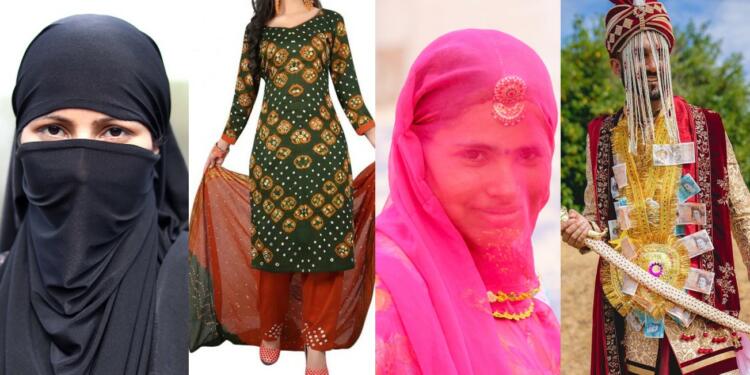Mughals ruled parts of India for a long period of time- 300 years to be precise. At the end of the day, Mughals were outside rulers. They had a Turkic-Mongol origin and they brought along their customs and culture from Central Asia.
Now, what is the most visible symbol of culture and identity? What one wears right. And the Mughals affected it the most. They simply changed how Indians dress up. Many of the present-day dresses and attires were a result of the Mughal rule. In fact, four parts of attire in India are a consequence of Mughal rule.
The ghoonghat (veil)
Now, the ghoonghat– a form of a veil by women is gradually disappearing. Apart from remote villages and some semi-urban areas, you won’t find many women wearing a ghoonghat.
But how did it become a part of the Indian dress anyway? In fact, veiling and seclusion wasn’t a part of the Indian culture in the Vedic era or even the post-Vedic era. So, how did it penetrate the Indian attire? The answer lies in the Mughal era.
During the Mughal rule and even during the era of Sultanates, it was common for senior officials or the emperor to lay eyes upon a woman and take her into his harem. During the Mughal era, this practice got normalised. The imperial Mughal harem itself had many Rajput women from Jodha Bai to Indira Kanwar. No commoner could resist if an emperor or even an official decided to include a woman in his harem.
During the wedding season, such actions got accelerated. Bridal party raids were common at the time, and something had to be done to overcome this.
So, to protect their daughters from Mughal emperors and their officials, people made two important changes.
- Organizing marriages in wee hours instead of early morning; and
- Using purdah or ghoonghat to seclude and veil women from the Mughal rulers.
In places where the Mughal rule was strong like North and Northwest India west, ghoonghat became too popular and a part of even the Hindu attire and ethos.
What the bridegroom wears
Today, we do not see a wedding without the sehra- white flower strings attached to the pagdi (turban) of the bridegroom to cover his face. But the traditional Hindu wedding in India involved only a pagdi (turban) on the bridge groom’s head and there would be no sehra suspended on the pagdi.
In some parts of India however, sehra has become a part of all weddings since the Mughal era. Even a practice called ‘sehra bandi’ is organised, especially in Punjab that basically involved tying the sehra.
In fact, the entire attire of a Hindu bridegroom has changed. Earlier, the bridegroom used to wear a dhoti and an angvastra (shoulder cloth or traditional stole). This was in accordance with the Indian climate and also the Hindu belief in favour of unsewed or unstitched clothes during religious activity.
Now, of course, sherwani, a dress that originated in the 16th and 17th centuries in Central Asia, has become the standard dress of most North Indian bridegrooms
Also Read: Chapter 1: Cultural impact of Mughals on Hindus: Urdufication of Hindi
Salwar Kameez
Now, this must have surprised you. You may have believed that salwar kameez originated in ancient India. But it actually doesn’t have an Indian origin.
In their paper Elucidation of Indian Salwaar Kameez, researchers Monisha Kumar and Amita Walia wrote, “The word ‘salwar’ has been used to describe loose fitted trousers fastened by drawstrings at the waist in Turkey, Persia and the Arab world. The word ‘kameez’ is originally Arabic and is used to describe a shirt of usually varied lengths.”
In the pre-Mughal era, it wasn’t a part of the traditional Indian attire. But very subtly and cleverly, Mughals made it appear as if it was an Indian dress and therefore it remains a part of Indian clothing even today.
Burqa
In India, wearing a burqa has been on the rise for quite some time now. But in the pre-Mughal era, the burqa obviously had no significance in India.
The burqa has an Arabic origin. But it has more to do with geography than with religion. It was in vogue there even during the pre-Islamic period. The burqa was meant to offer protection against animals especially during the winter months and was also used as a covering chaadar by village women.
But India doesn’t really have an Arabic geography. However, with time, the attire has become a religious symbol, and this is why it is used in India.
Indian attire was actually quite different before the Mughal era. But Mughal rule changed the most visible representation of a culture, that is, its attire upside down.

































Interesting!!! Maybe south India does not have so much influence of Arab world. For instance, guruvayoor temple that has strict dress codes for men and women did not allow salwar kameez for girls/women. There are very strict rules for men also (check out PM Modi entering the temple following their rules). After lot of hue and cry mainly by devotees caught unaware by not knowing these rules – they now allow salwar kameez for girls. However last I checked, the famous Mammiyur temple stuck to the same rules. They provide alternate dress for those who may need.
To reclaim our pride and Sanatan Dharmik Vedic culture we MUST revert to our Original forms, whether dress code, culinary, music or linguistic patterns … and get free from the bollywoody islamic clout and influence!